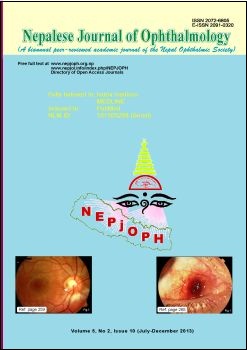Indications for keratoplasty in Nepal: 2005 - 2010
DOI:
https://doi.org/10.3126/nepjoph.v5i2.8730Keywords:
keratoplasty, infectious keratitis, developing countries, corneal blindnessAbstract
Introduction: Corneal disease, especially infective keratitis, is one of the major causes of visual impairment and blindness in developing countries.
Objective: To find out the current indications for keratoplasty, how these indications have changed over time as well as how they are different from those in other parts of the world.
Materials and methods: A retrospective study of a case series of 645 keratoplasty surgeries (589 patients) was conducted at the Tilganga Institute of Ophthalmology from January 2005 to December 2010.
Outcome measures: The cases were evaluated in terms of demographic parameters, preoperative diagnosis and the type of surgery performed.
Results: The most common indication for surgery was active infectious keratitis (264 eyes, 40.9 %), followed by corneal opacity (173 eyes, 26.8 %), regraft (73 eyes, 11.2 %), bullous keratopathy (58 eyes, 9.0 %), keratoconus (45 eyes, 7.0 %) and corneal dystrophy (11 eyes, 1.7 %). The mean recipient age was 41.7 ± 19.9 years with over a half of the patients between 15 to 49 years of age. More men (64.1 %) underwent keratoplasty than women (35.8 %). 59.8 % of the eyes with infectious keratitis had a perforated corneal ulcer. 49.7 % of corneal opacities were due to previous infectious keratitis. 72 % of regrafts were for endothelial failure of various causes. In older patients (> 50 years), bullous keratopathy was an important indication, after infectious keratitis. Keratoconus and corneal scar were major causes of keratoplasty in children of 14 years or less. Four percent of the patients had keratoplasty in both the eyes. 17.1 % of the patients who had one eye operated on had a blind fellow eye with a vision of less than 3/60.
Conclusion: Currently, keratitis, either active or healed, is the major indication for keratoplasty, suggesting that improved primary eye health care is necessary to decrease the prevalence of corneal blindness.
Nepal J Ophthalmol 2013; 5(10): 207-214
Downloads
Downloads
Published
How to Cite
Issue
Section
License
This license enables reusers to copy and distribute the material in any medium or format in unadapted form only, for noncommercial purposes only, and only so long as attribution is given to the creator.




